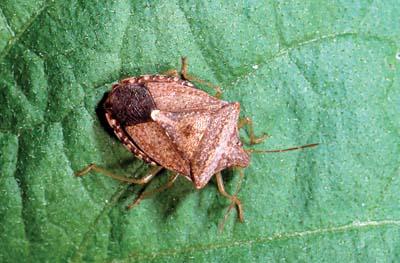Brown Stink Bug, Euschistus servus
(Hemiptera: Pentatomidae)
The brown stink bug is a native insect and is found throughout the United States. There are usually two generations per year and the adult is the overwintering stage. Eggs are laid from May to August and are yellowish-white and barrel-shaped. The nymph is yellowish-brown with a white or yellow abdomen. Red markings may also be found on the abdomen. The antennae are reddish-brown. Adults are brown or grayish-yellow and produce a distinctive odor when disturbed.
Vegetable crops that are commonly attacked are bean, cabbage, corn, cowpea, okra, pea, pepper, squash, and tomato. Alternate hosts include cocklebur, curly dock, goldenrod, ragweed, pigweed, and thistle. Damage is caused by nymphs and adults feeding on tissues, buds, and fruits. Deformed fruit, aborted blossoms, or death of young tissue are all signs of damage by the brown stink bug. Insecticides are commonly applied to manage populations of brown stink bug. Cultural control practices include removal of alternate hosts and weedy areas and tillage.
Images
To save the Web-optimized images shown below to your hard drive:
PC users: right click to "Save Picture (or Image) As..."
Mac users: click and drag to your desktop.
Copyright © 2005 University of Florida
